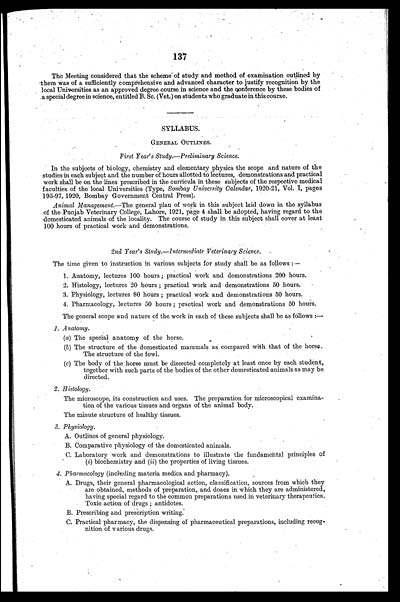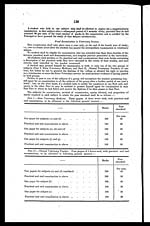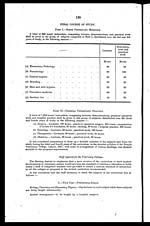Medicine - Veterinary > Civil Veterinary Departments > Proceedings of the meeting of veterinary officers in India > Proceedings of the second meeting of veterinary officers in India
(203) Page 137
Download files
Individual page:
Thumbnail gallery: Grid view | List view

137
The Meeting considered that the scheme of study and method of examination outlined by
them was of a sufficiently comprehensive and advanced character to justify recognition by the
local Universities as an approved degree course in science and the conference by these bodies of
a special degree in science, entitled B. Sc. (Vet.) on students who graduate in this course.
SYLLABUS.
GENERAL OUTLINES.
First Year's Study.—Preliminary Science.
In the subjects of biology, chemistry and elementary physics the scope and nature of the
studies in each subject and the number of hours allotted to lectures, demonstrations and practical
work shall be on the lines prescribed in the curricula in these subjects of the respective medical
faculties of the local Universities (Type, Bombay University Calendar, 1920-21, Vol. I, pages
195-97, 1920, Bombay Government Central Press).
Animal Management.—The general plan of work in this subject laid down in the syllabus
of the Punjab Veterinary College, Lahore, 1921, page 4 shall be adopted, having regard to the
domesticated animals of the locality. The course of study in this subject shall cover at least
100 hours of practical work and demonstrations.
2nd Year's Study.—Intermediate Veterinary Science.
The time given to instruction in various subjects for study shall be as follows:—
1. Anatomy, lectures 100 hours; practical work and demonstrations 200 hours.
2. Histology, lectures 20 hours; practical work and demonstrations 50 hours.
3. Physiology, lectures 80 hours; practical work and demonstrations 50 hours.
4. Pharmacology, lectures 50 hours; practical work and demonstrations 50 hours.
The general scope and nature of the work in each of these subjects shall be as follows:—
1. Anatomy.
(a) The special anatomy of the horse.
(b) The structure of the domesticated mammals as compared with that of the horse.
The structure of the fowl.
(c) The body of the horse must be dissected completely at least once by each student,
together with such parts of the bodies of the other domesticated animals as may be
directed.
2. Histology.
The microscope, its construction and uses. The preparation for microscopical examina-
tion of the various tissues and organs of the animal body.
The minute structure of healthy tissues.
3. Physiology.
A. Outlines of general physiology.
B. Comparative physiology of the domesticated animals.
C. Laboratory work and demonstrations to illustrate the fundamental principles of
(i) biochemistry and (ii) the properties of living tissues.
4. Pharmacology (including materia medica and pharmacy).
A. Drugs, their general pharmacological action, classification, sources from which they
are obtained, methods of preparation, and doses in which they are administered,
having special regard to the common preparations used in veterinary therapeutics.
Toxic action of drugs; antidotes.
B. Prescribing and prescription writing.
C. Practical pharmacy, the dispensing of pharmaceutical preparations, including recog-
nition of various drugs.
Set display mode to: Large image | Zoom image | Transcription
Images and transcriptions on this page, including medium image downloads, may be used under the Creative Commons Attribution 4.0 International Licence unless otherwise stated. ![]()
| Permanent URL | https://digital.nls.uk/75515579 |
|---|
| Description | Held at Calcutta from the 22nd February to 2nd March 1923. |
|---|---|
| Shelfmark | IP/RA.7 |
| Additional NLS resources: | |




